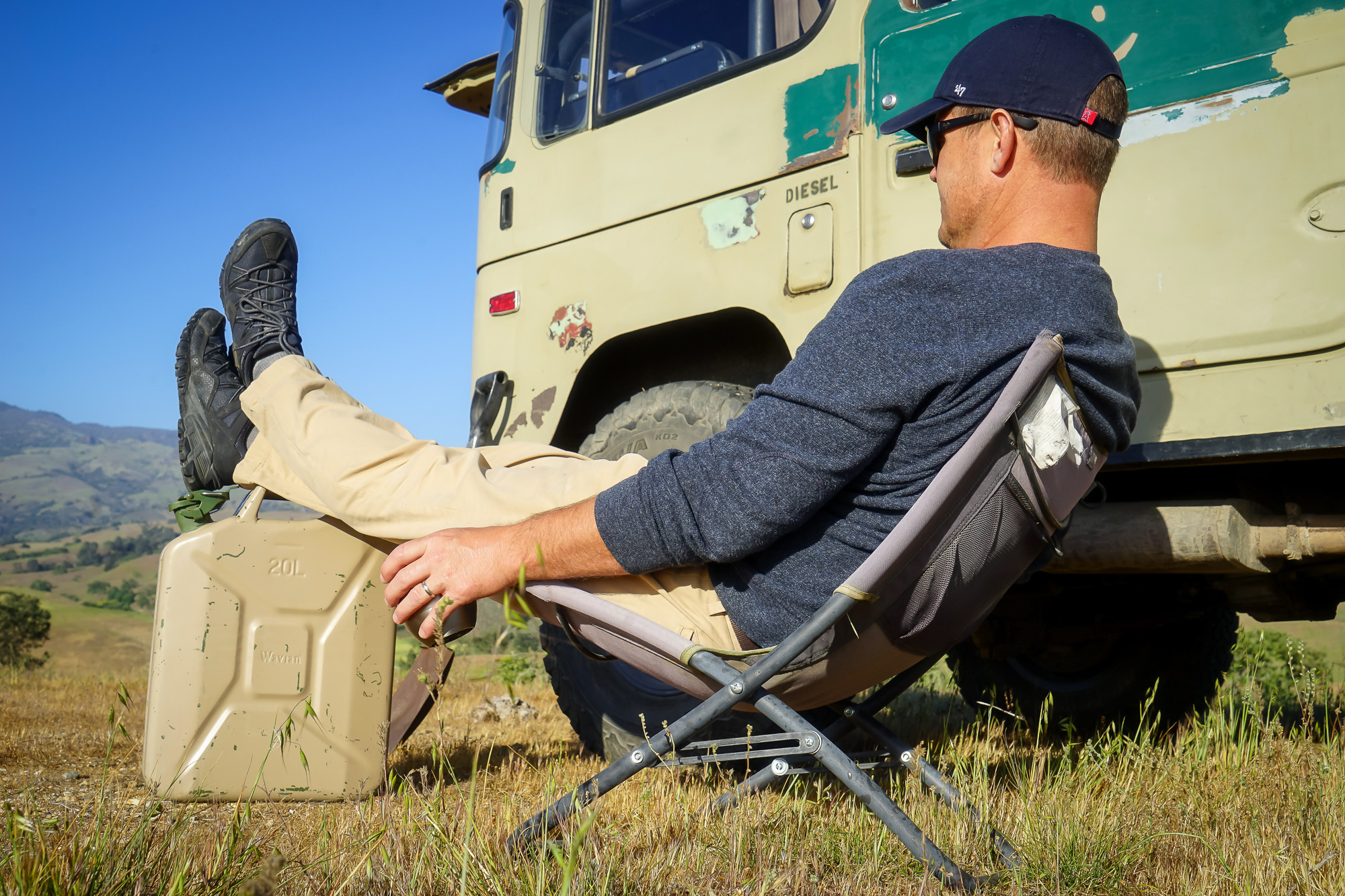Editor’s Note: This article was originally published in Overland Journal’s Gear 2022 Issue.
The ancient Greek physician Hippocrates, credited with the oath that guides the ethics of modern physicians, expounded that walking is man’s best medicine. And Marilyn Monroe stated that if you give a girl the right shoes, she can conquer the world.
Shoes have been around for well over five millennia. The Copper-Age hiker Ötzi discovered thawing from glacier ice in the early 1990s (we mentioned his backpack in the Winter 2020 issue), sports intact mountaineering kicks insulated with hay, with a bearskin sole strapped to a deerskin upper. Ötzi’s claim to the oldest known shoes is beaten by just a few centuries by a well-preserved 5,500-year-old shoe found at Areni-1 Cave in southern Armenia. Constructed from a single piece of cowhide, it includes a lacing system, tapered toe box, and sole reminiscent of modern climbing shoes. A few thousand years later, the Roman Army issued shoes to the troops, and with good reason. They trekked through arid deserts, snow-capped mountains, and manky bogs all over Europe, North Africa, and the Middle East. Shoes protect our feet and facilitate access to places we normally wouldn’t go barefoot. Shoes have also been considered fashion statements since at least Greco-Roman times. Essentially, we’ve been covering rough ground, in style, for thousands of years.
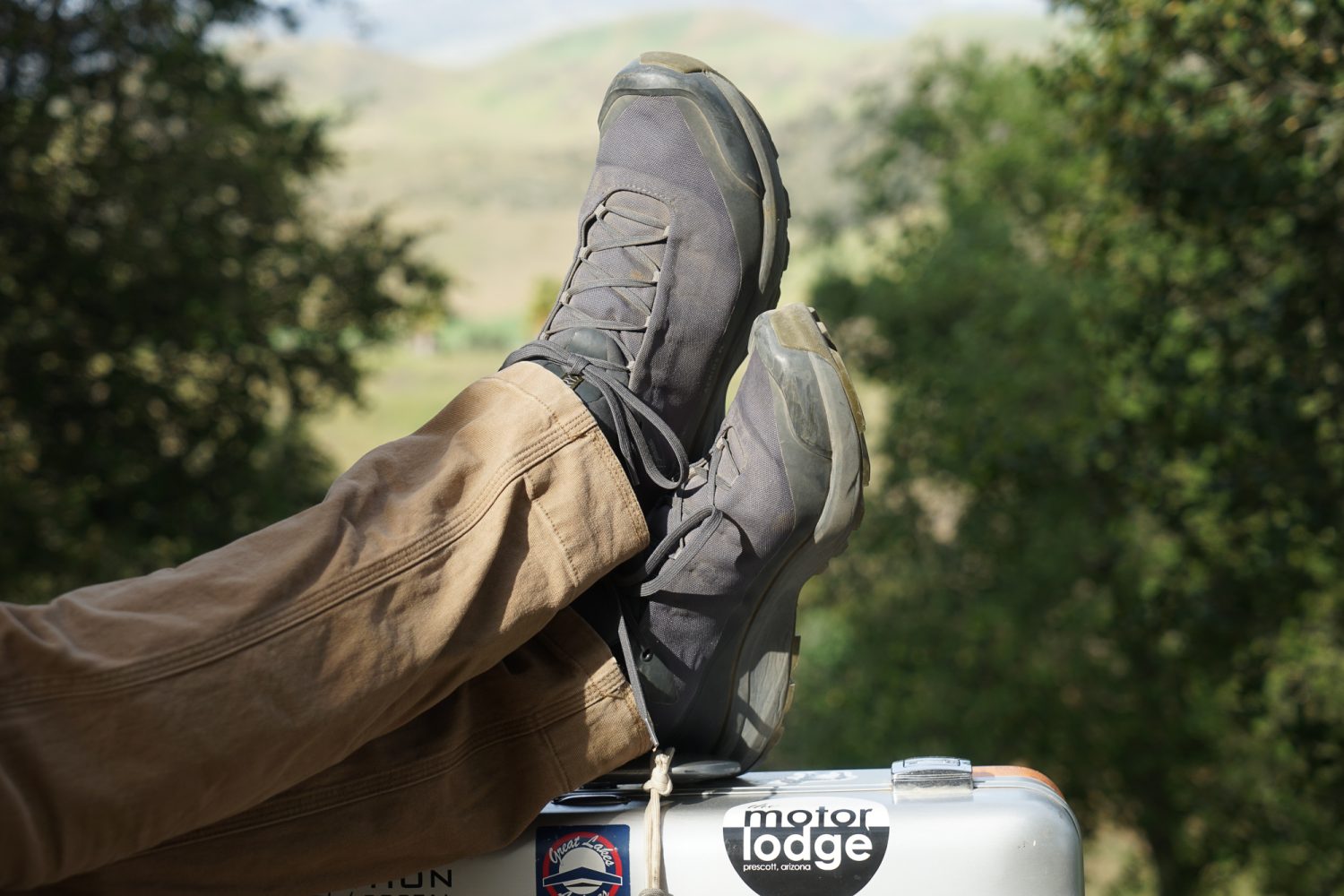
When researching shoes, travelers should contemplate all intentions for the footwear, including anticipated conditions, ability to repair, adaptability to different sock thicknesses, if they’ll have professional/meeting obligations, backpack weight, and technical capabilities. In addition, shoes have to function indoors and be comfortable for extended periods on the accelerator, brake, and clutch pedals. Color might be important to match your travel clothes or not to stick out in public or cultural settings. Shoes alone probably won’t provide onlookers complete information and one’s culture or status, but add a few other cues, and they might. Conversely, all this may be irrelevant for your destinations or personal worldview.
The shoes tested here have solid merits and exemplify different genres. Choices become convoluted with so many varying features, colors, and other ocular lures. We’re not concerned with shoes for a week in Rome, although if you’re then heading to Uganda, specific factors might be pertinent. Gore-Tex doesn’t always matter. Runners and trail runners are not necessarily great for extended wear. Some trail runners are actually light hikers. Hiking shoes, by definition, should have all-day comfort. Approach shoes should also be comfy for long periods; adjustments are expected as daily activities change. Ultimately, our focus here is on the underlying travel shoe philosophy and desirable features and capabilities.
On Cloudventure Waterproof Trail Runner (black/graphite)
Founded in 2010 out of Zürich, Switzerland, On shoes emanate from the runner’s world. An amalgam of registered trademarks holds the Cloudventure Waterproof together. From the ground up, On’s intellectual property includes their cleat-like Missiongrip outsole, which underlies their CloudTec midsole. The latter is claimed to reduce muscle fatigue and lower heart rates (don’t argue, it’s verified by the Eidgenössische Technische Hochschule, Zürich). Then comes their Speedboard “liquid injected plate of thermoplastic polymer,” followed by a waterproof outer membrane. So what happens when the rubber hits the road?
The Cloudventure Waterproof has a perceived break-in period, initially wearing stiff and loosening soon after. Intended for tackling Switzerland’s rugged alpine terrain, these trail runners seem a bit rigid around the toe box. They size slightly small, so with thicker socks, they can feel snug. If cranked down, the thin laces bite into the tongue, which can cause uncomfortable pressure if not readjusted later. With its serious lugs, the distinct outsole is quite noticeable, appearing more like mountain bike shoes. The cleat-like lugs are chunky, and the tread material is slick and hard rubber. This can preclude confident grip on certain smooth surfaces, specifically man-made environments like polished concrete. When transitioning from gravelly outdoor settings to flat surfaces, sizable rocks are prone to hitch rides between the lugs.
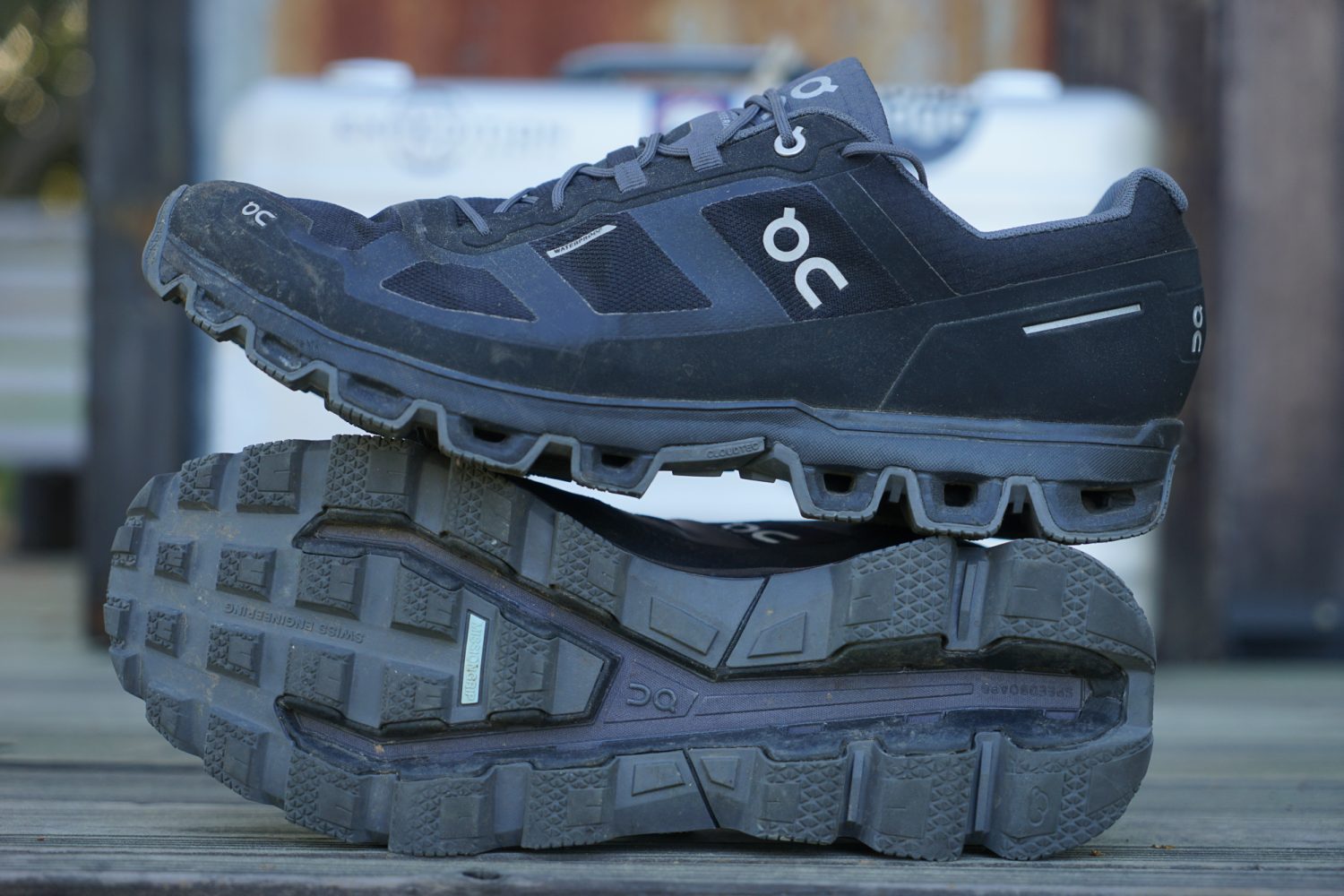
For midnight latrine runs, where a quick donning might be desired, the stiff heel cup can hinder easy slip-on unless the laces are thoroughly loosened. These are light on the feet yet feel durable and perform appropriately on rough and varied technical terrain requiring serious traction. On’s waterproof outer keeps the socks dry. As expected, with their runner’s pedigree, the Cloudventure Waterproof excels on jogs and trail running.
The shoes are low profile yet snug around the ankle, which prevents easy ingress of dirt and vegetation. The Cloudventures fit well under trouser cuffs. The profile, cut, design, tread pattern, and overall look are distinct. The performance look, abstract logo, and very clean outer appearance could suggest someone with resources, but they could blend in at certain locales.
With superb waterproofing and a very aggressive tread, they’re perfect in challenging terrain. The bold appearance and high performance might be overkill for a travel shoe. For some, all-day comfort might be lacking in these runners. The laces are easily removed and can be expeditiously replaced. Cloudventure has minimized lateral stability around the ankle. On a trail runner, this aspect, combined with the slightly elevated heel (due to the large lugs), might not work for everyone, including people carrying heavy packs.
$170 | on-running.com
The North Face Ultra 111 WP Trail Runner (TnF black/dark shadow grey)
The North Face of Mount Everest, where Mallory made his tragic summit attempt, is also synonymous with mountaineering and field gear from a firm bearing that namesake. My first down vest was from The North Face, and I read the writing on the snaps as Face The North. Many camping excursions later, my father laughingly corrected me. In the 1990s, I had the opportunity to work with Greek colleagues on Cyprus. Advised of temps exceeding 100ºF and that my archaeological contemporaries would mostly wear flip-flops at the excavation, I abandoned my must wear boots mantra and bought into The North Face’s newest gear: trail-running shoes. Over 20 years later, a Croatian buddy asked if he could repurpose the laces and convert the shoes, still in good nick, to slip-ons. I capitulated.
Sporting waterproof mesh uppers, fairly cushy EVA midsoles, protective toe caps, and a medium-aggressive tread on their UtrATAC rubber outsole, the Ultra 111 WP (waterproof) shoes are comfortable right out of the box. They are supportive, cinch down well, and don’t have quirky pressure points. With true-to-fit sizing, they still wear fine with thicker socks.
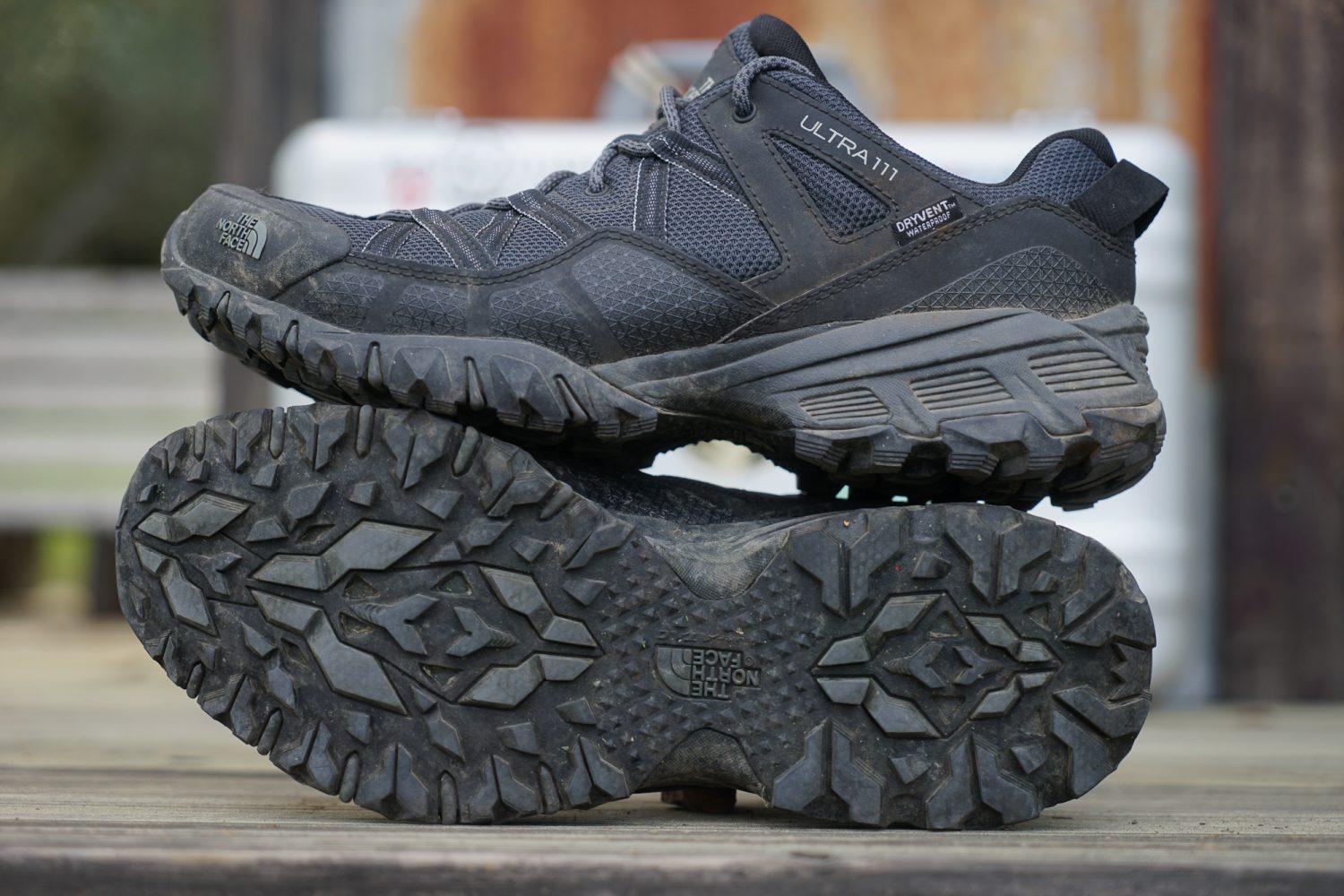
The Ultra 111s present as a hiking/trail-type shoe and appear more bluish/black than their specified color suggests. In camp, don’t expect these to slip on easy for that brisk trot over to your pal’s beer cooler unless you’ve really loosened the laces. The Ultra 111s are light, possibly on the heavier side for a trail runner, and feel more like agile hiking shoes. In this regard, they wear great all day and promote confidence on long hikes with varied terrain, including more technical pursuits like bouldering. Their extra rigidity and support are welcome on the trail. Over time, on hotter days, the Ultra 111s may require some readjusting.
They have proper support and cushioning for impulsive jogs, but they seem slightly weighty as a frequent-use running shoe. The Ultra 111s don’t wear clunky, and the ankle fitment doesn’t invite dirt into the shoes. The outsole isn’t too aggressive; still, it does retain pebbles. The North Face Ultras don’t have any gimmicky features or components. With long pants, cuffs don’t tend to bunch at the tongue or heel. Their laces hold a knot, could secure your Birdwell boardshorts in a pinch, and can be replaced with P-cord.
You’re sitting outside at a bar in Cusco, Peru. Do these shoes provide insight into the wearer’s continent of origin? The subdued colorway and style alone do not; add another cue like white socks, and it’s probably a North American hiker. More recognized footwear brands obviously dominate the trail-runner space, but for a company that makes other gear, including their hardcore Summit Series expedition kit, The North Face Ultra 111s are unexpectedly impressive.
$120 | thenorthface.com
Salomon Wildcross Trail Runner (non-GTX), dark denim/black/navy blazer)
The Salomon brand started making ski bindings in the French Alps. Many decades later, the mark has established new benchmarks for rugged field shoes and boots. In their trajectory to capture market share, the firm gathered valuable experience developing alpine and cross-country ski boots, skis, and snowboards. They are not afraid to innovate yet stay loyal to the outdoor footwear audience. Some of their shoes and boots just look out of place in urban settings. It’s not surprising that outdoor recreational enthusiasts, adventure travelers, and even elite military and law enforcement units favor their footwear.
Salomon’s Wildcross shoes don’t require break-in and fit true to size. The lacing starts higher up the foot than some other models and makes the Wildcross toe box feel wider. The fit is reassured by rubber toe caps and their SensiFit system that cradles your foot, so your toes feel shrouded. Not surprisingly, the shoes are comfortable for all-day wear, and thick socks work well with this design.

Salomon’s Quicklace system with thin Kevlar laces requires some attention to don and remove the shoes. Even with this retention system fully loosened, most wearers still need to do the finger-as-shoehorn maneuver at the heel to slip them on. It is idiosyncratic to every Salomon I’ve worn with their Quicklace system. These kicks, highlighted by the Contagrip TA outsoles, look like BFG mud-terrain T/A KM3s fitted to a running shoe. The lugs are widely spaced, have dynamic traction, and clear debris (including gravel).
The Wildcross has water-repellant TPU mesh uppers to keep splashes and mud splatter at bay—for a while. These wear more like featherweight running shoes, hold up after daily hikes and runs, and seem best suited for desert or woodland trails. The knobby outsole and nylon mesh upper of these lightweights will probably have issues after too much shale or lava rock. They facilitate nimble movements over challenging terrain and are best paired with 3-season travel and light packs.
Long pants cuffs can bunch behind the tongue, especially if you aren’t sano tucking the Quicklace ends into the tongue and flattening out the arrangement. With Quicklace, you don’t need to worry about holding a knot. However, if the Kevlar lacing or plastic lock mechanism breaks, you may have issues without Salomon’s repair kit. Paracord inner strands could work, but you’ll have some downtime sorting that out. If removed, the Kevlar laces can also be used as a friction device to cut materials. The colors don’t draw attention, and these shoes alone may not divulge the owner’s continent of origin. Like other Salomons, the aggressive look suggests that the wearer knows their business. In some locales, people would take note.
$130 | salomon.com
Arc’Teryx Aerios FL Low GTX Shoes (cinder/bushwack)
Canadians design outdoor gear right the first time around, probably because their winters can be harsh, and the landscapes are not for the timid. When remote in Canada, you don’t even see jet contrails overhead—and they have animals that eat people. Arc’Teryx packs and outerwear, frequently more expensive than competitors, are prime examples of the “buy once, cry once” philosophy. I own Arc’Teryx gear that’s been nearly 20 years afield, and it’s still going strong. The firm only recently entered the footwear arena, and it’s pretty clear they weren’t just relying on their existing portfolio to establish a foothold. A skeptic of the outdoor shoe bandwagon, I was nevertheless stoked to try out their kit.
The Aerios FL GTX Shoe is surprisingly minimalist. There isn’t too much intellectual property called out in their spec sheets, except for the usual suspects of Gore-Tex and Vibram. Straight from the box, the Aerios is true to fit and wears all day like a champ with no break-in required. I found the toe box spacious, and my feet are on the wider side. Like Salomon’s Wildcross, the lacing across the foot’s bridge isn’t a webbed morass. Thicker boot socks make the shoes snug but not uncomfortable.
This pair’s colorway is fairly low profile, if not downright bland. Before contact with trail dirt, someone commented that they looked “generic and orthopedic.” I couldn’t disagree. However, once outsoles hit silty sands, their presentation changed, and the shoes looked the part. If donning expediency is necessary, Aerios do slip on easier than most other shoes in the evaluation. Perhaps out of habit, I still poke fingers down the back.
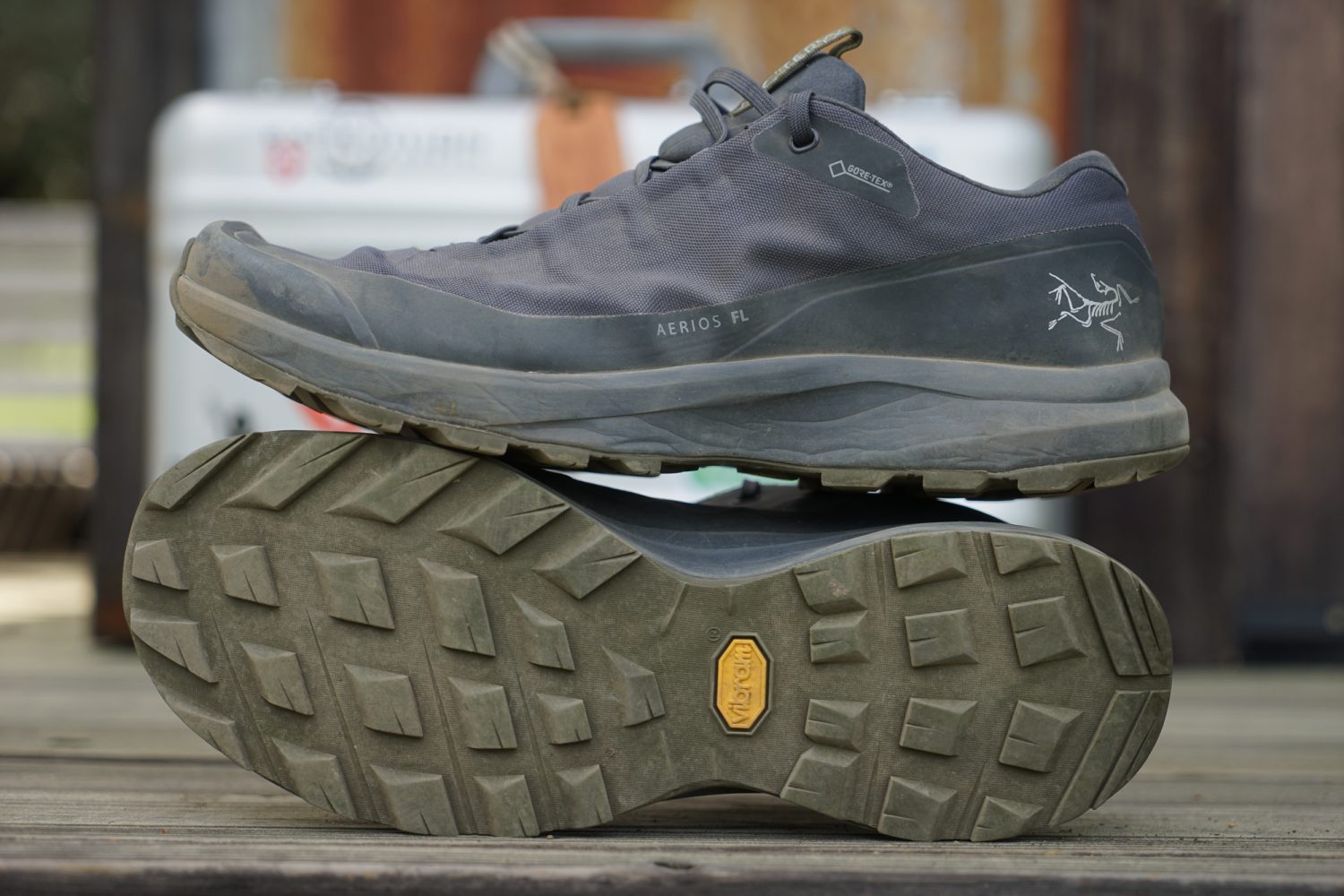
The Aerios FL GTX is very agile. They definitely don’t look like lightweight runners, but they excel at trail running and mixed urban-terrain jogs. Some qualities always give with leaned-out footwear, and the Aerios is not immune. I wouldn’t subject the thin Gore-Tex uppers to sustained abrasive environments like craggy bouldering. They wouldn’t be the best choice for extended trips with a heavy rucksack; stiff lateral support isn’t there. Laced down, they don’t invite debris, and most pant cuffs fall over the tongue and heel.
The Vibram Megagrip outsole is a tractive sleeper agent. In profile, they seem benign, but the chunky design combined with a medium-hard rubber compound makes them suitable on most wet or dry terrain, including human-made surfaces. The lacing can be easily improvised with P-cord. Aerios make an excellent minimalist waterproof hiking and travel shoe, or even an approach shoe under certain conditions. They’re slightly funky; however, they seem to match most adventure travel clothing selections. Lacking stripes and lightning bolts, these could still get you past the safari lodge’s maître d’ and into the fine dining room.
$170 | arcteryx.com
Salewa Wildfire Edge GTX Approach (black/black)
Old-school approach shoes were the leanest field sneaks in the quiver. More like gussied-up climbing shoes, they’re meant for hiking, surmounting rock features along the way, and ultimately arriving where the serious mountaineering happens. Envision them with thin outsoles, sticky treads, laces down to the toes, almost no padding, and being barely water-resistant. They’d leave telltale black scuffs on kitchen floors. If worn around climbers, you’d better talk the talk. Waterproof trail-runner-type designs with semi-technical outsoles and better protection came along, so some people ditched the austere approach treads.
What if Toyota made a fresh run of the FJ40, incorporating modern technology only where it really mattered, leaving everything else old school? That’s Salewa’s Wildfire Edge GTX Approach for you. Out of the box, they fit true to size and wear like a casual shoe. The tongue has a good range of motion, so they’re easy to slip into without much commotion. The Switchfit lacing system is simple yet unique. Two additional eyelets (high-visibility yellow) are aft of where one typically ties the knot. Lacing through these cinches the rear of the shoe into the heel and pushes the foot forward. That’s the climbing and technical terrain mode. Loosen the laces, or pull them back out of the yellow eyelets and retie the knot, and you’re in hiking shoe mode. Thicker socks work fine with both lacing systems but are better in the hiking setup. The laces can be replaced with paracord sheath (remove the inner strands).
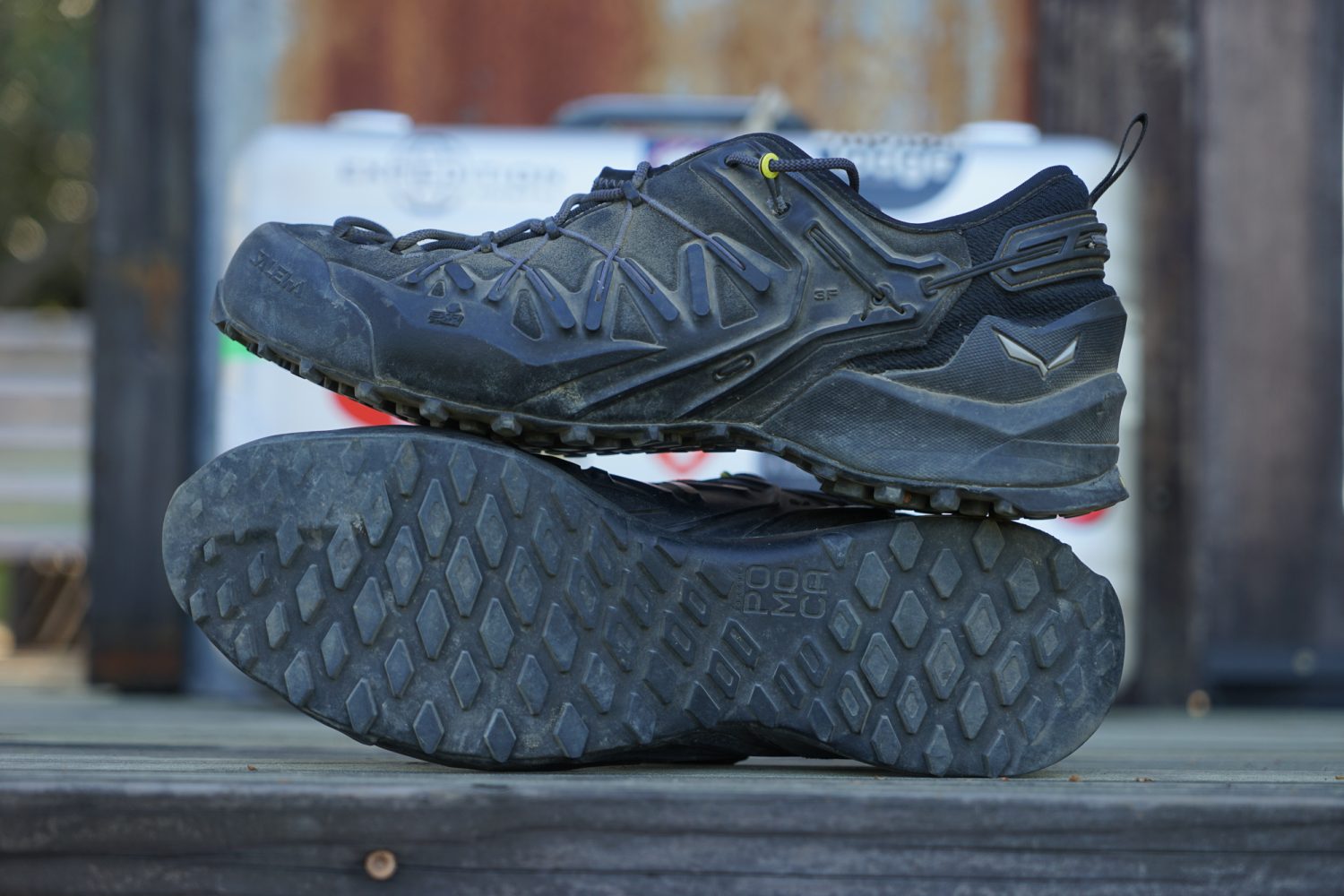
Seriously scuff-resistant suede leather and a breathable microfiber upper is overlain on the sides by Salewa’s 3F/Exa shell (essentially a semi-rigid ribbed rubber exoskeleton that also secures to the eyelets) and underlain by a Gore-Tex layer. This ensemble is highly protective, waterproof, and supportive. Their Pomoca Speed MTN outsole is very sticky on most wet and dry surfaces. Salewa also maintains the critical flat patch under the toe for tackling the crux. The lug design provides superior dirt traction, but it also attracts pebbles. These hitchhikers frequently offload on interior mud mats, and you’ll also hear them as you walk across your mate’s Defender 110 bonnet. Wildfire Edge GTX has its Edging Plate to stiffen the forefoot for critical climbing moves. On the hike, this feature is not perceptible. The footbed, part of Salewa’s Alpine Fit blister-free assurance, can be fine-tuned with inserts.
The Wildfire Edge is a comfortable all-day shoe with superior technical capabilities. They’re also right at home as a basic hiking shoe and feel fine for a trail hustle, although they’re not built to be daily runners. Pant cuffs don’t bunch on the heel or tongue. While designed for specialized use, in this colorway, they look, well, fashionable. Overall, they tick quite a few of the ideal travel shoe boxes.
$190 | salewa.com
Asolo Agent Evo GV Hiking Shoes (graphite)
Significant tasks are slated for completion on a winter project in the Balkans. The in-country project manager says I’m on the critical path: no show, no progress. The knock-on effect pushes workflow six months forward, which means a year. Corporate travel scrounges low-season flights, but I’d need two nights in Zürich for connections. Fortunately, I have aces in the hole there (colleagues’ couches) and unrelated work I could spontaneously drum up (mostly, cocktail hour meetings). It’s light and fast travel—all carry-on, no pocket knife (okay, knives), one merino wool underlayer, and one pair of shoes to cope with long-haul flights, winter field conditions, and contractor meetings. Oh, and the Swiss social gatherings. I then discovered the Asolo Agent.
The Asolo Agent Evo GV hiking shoes are slightly stiff from the box, probably from the Gore-Tex-lined, suede-leather uppers. Thirty minutes of wear, and we were best friends. True to size, these have all-day comfort. They’re fine with thicker socks. I’d recommend loosening the laces and readjusting. Paracord can replace these laces.
Asolo Agents are almost a guest in the hiking shoe space. The lacing, straight from the approach shoe playbook, extends far down and is great for micro-adjustments. Likewise, the abrasion-resistant rubber toe cap (classic climbing shoe design) not only covers the suede and Gore-Tex toe box but also tucks under the outsole and midsole interface. My Asolo Agents have been soaked in water and then sun-dried hundreds of times, with zero separation in this area. This is bomber mountaineering construction at its best. The new Agent has a more streamlined suede leather and Gore-Tex tongue with a single leather slit, through which the laces pass to secure the tongue.
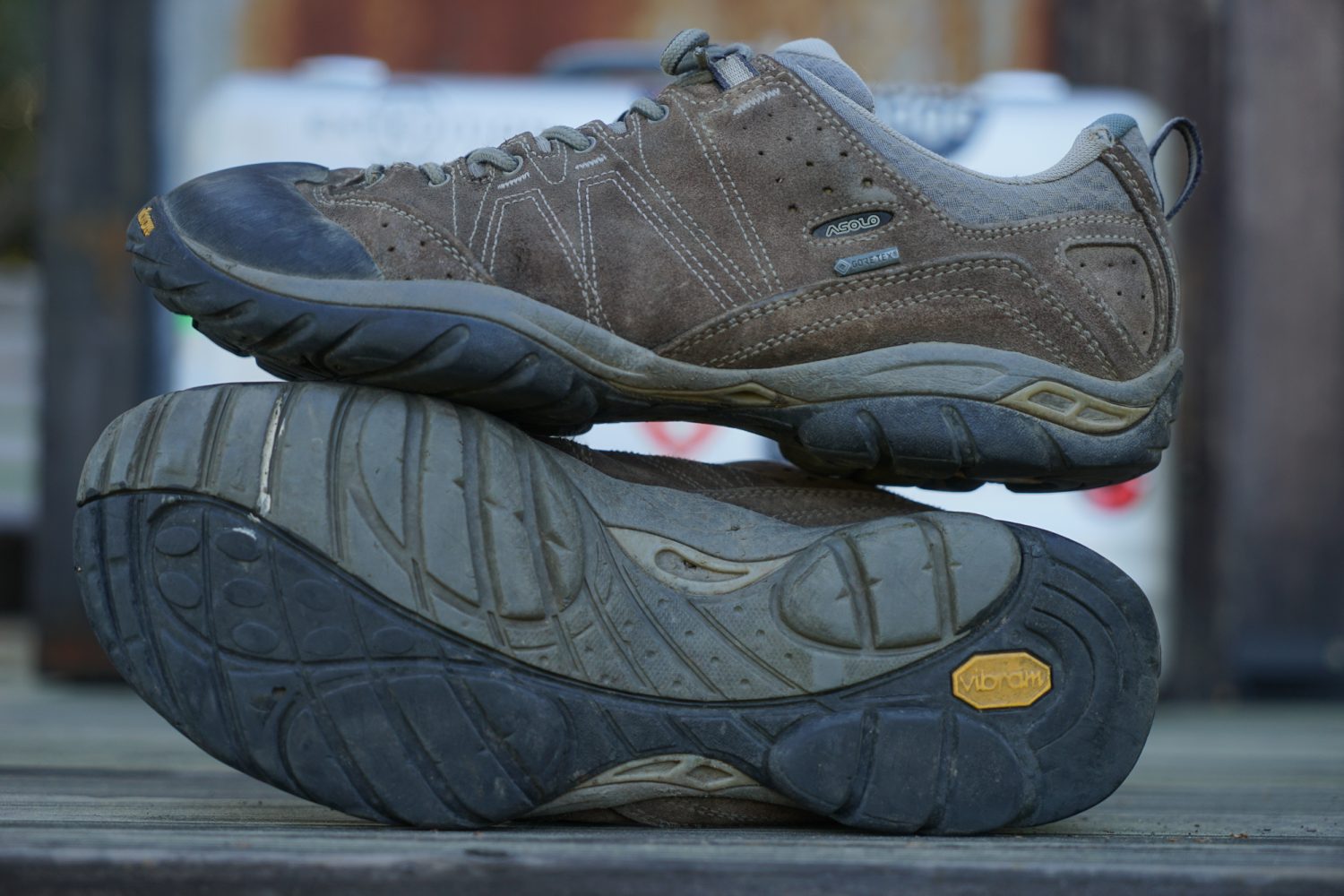
Vibram Megagrips have the bottom covered. This outsole blends nicely into the cushy EVA midsole, offering excellent protection from jagged rocks and other unwelcome sharpies. The new tread pattern (not pictured) surpasses the original with better traction and more ground patch but is moderately prone to retaining gravels. The heel cup is rigid yet padded. These shoes don’t appreciate being mistaken for slip-ons. Deal with the laces, pull up the tongue, and get on with it. Most pant cuffs should drape over the Agents.
Agent Evo GVs are hikers, so they’re heavier than runners and most trail runners. I can’t say I’ve jogged with them, although I’ve certainly hustled the Agents during plenty of field surveys, and of course, abundant speed-walks and sprints to catch connecting flights. Asolo mostly nailed the color on these. I could do without the whitish-gray flashes in the midsole. Nevertheless, these hit close to the adventure travel shoe bulls-eye. Attention to construction materials and superior design is what you get.
$210 | asolo.com
Acknowledgements
Three people assisted with the field test and evaluation. RS is a retired US Navy SEAL combat veteran with over 20 years of service. He’s an avid hiker, outdoor enthusiast, and knife maker. TH is a current law enforcement sergeant, public safety dive team leader, and outdoor enthusiast. He’s a former ANGLICO Marine combat veteran, SWAT team member, and detective. ME has a bachelor’s degree in recreation administration and a master’s in education. He is the outdoor recreation coordinator for a university in California and is a dedicated hiker and traveler.
Our No Compromise Clause: We carefully screen all contributors to ensure they are independent and impartial. We never have and never will accept advertorial, and we do not allow advertising to influence our product or destination reviews.
Read more: Salewa Dropline Men’s Shoe


